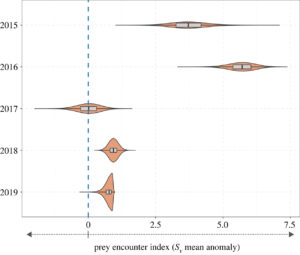[ad_1]
As humans forage to find snacks in their fridges, the little penguin forages in the sea, but just how effective are they in finding prey?
Phillips LR, Carroll G, Jonsen I, Harcourt R, Brierley AS, Wilkins A, Cox M. 2022 Variability in prey field structure drives inter-annual differences in prey encounter by a marine predator, the little penguin. R. Soc. Open Sci. 9: 220028. https://doi.org/10.1098/rsos.220028
Everyone is hungry
Just as people search for food in their fridges with variable success, marine predators try to do the same in the sea, where the way prey is found is highly variable. Prey form aggregations for several reasons, like facilitating their movement, avoiding predators, etc. These patches of prey can vary horizontally and vertically, making it all more complicated for predators. Ecologists strive to understand better how prey variability work and how predators can detect them.
As we can imagine, predators have strategies to better their chances of finding prey. Consequently, their movements could be used to find and study prey aggregations, where they can be found and how they vary through time. Studies use indirect ways of measuring prey distribution, but they can end up inducing mixed results. So, what did this study use?
Acoustics… but not the musical kind
Through acoustic surveys, it is possible to study prey groupings while also giving their vertical distribution, contrary to other methods (like trawl surveys). Not only that, but it gives information about prey species and their size class.
As with every scientific method, acoustic surveys not only have advantages but also disadvantages. It is difficult to connect the results of prey distribution and structure with marine predators’ behaviour. This depends on having previous knowledge of how predators forage, which is particularly challenging with extremely mobile marine vertebrates.
However, not all predators are that mobile. Sea birds, during the breeding season, are way more constricted to one foraging zone and thus can be related to prey distribution.
Studying the little Pingu, I mean penguin
The focus of this study was the little penguin (Eudyptula minor) and its foraging behaviour in southeast Australia over five years (2015-2019). Specifically, they were from a breeding colony on Montague Island (36°15.11 S, 150° 13.60 E) next to New South Wales. These penguins were limited to single-day trips for finding food as they were brooding chicks and couldn’t go further than 25 km away from the colony. This way, the study could focus on a smaller area and the penguin’s behaviour during an energetically costing period.
This part of Australia presents de East Australian Current (EAC) which is warm and has low levels of nutrients. It is very dynamic and influential in the structure and distribution of resources in coastal ecosystems. There is evidence that this dynamism and strength that the EAC presents has been increasing, which is influencing prey distribution and availability. Sea birds (and thus our little penguin) depend on them as an energy source to carry out breeding. Therefore, it is crucial to further understand how their foraging and prey distribution can be connected.

While on a boat and using acoustics, this study thrived to find out if the structure of the prey field can serve as a predictor of little penguin foraging, and what kind of strategies they use to find prey in this dynamic scenario. In addition, different strategies could end up presenting different body weights caused by success in catching prey.
During the study, penguin tracks were simulated to establish whether penguins could find prey better than random. This simulation presented similar movements to actual penguins but randomly.
Interpreting the acoustics
In general, foraging was focused close to the coast, except for 2017 which happened farther offshore. There were 31 208 dives, short and shallow; 62% were within the top 10 m of the water column, and more than 99% were within the top 30 m.
Acoustic densities worked as representatives of prey density, which varied between years. For example, density was higher in 2015 and lower in 2017 and 2019. In both of these last two years, acoustic density was sparse; particularly, in 2017, the highest acoustic density levels were deeper than 20 m. In contrast, although in 2019 densities were also sparse, they concentrated within the top 5 m, where penguins focused their foraging efforts.
Acoustic density was higher within 5 km of the coast in all the study years. In 2015 and 2016, it was particularly clear how penguins’ foraging area overlapped with areas with high acoustic density near the coast. Their dives were above 20 m of depth, even when acoustic density went farther below like in 2017. Perhaps penguins’ ability to detect prey is limited to depth and diving energy costs; even if they could potentially reach those depths, it would be very costly.
Speaking of, penguins had better prey encounter indices than the simulated penguins for 99% of the time except in 2017, when they were just about equivalent. On the other hand, in 2015 and 2016 penguins greatly outperformed the simulations (Figure 1).

To finish the hunt
In this study, they researched whether little penguins’ movement could serve to track the prey field’s structure and how they changed their behaviour to enhance the chances of successfully finding them. This was done by comparing real penguins’ behaviour with simulated tracks and contrasting their dive depths with the vertical distribution of acoustic densities. They were far more successful than the simulated ones, but not in some years which was reflected in their body mass. What we take from this is that prey field structure and its variability reflect on penguins’ prey encounter rates and it ends up influencing their fitness.
We can see that depth and prey density highly influences penguins’ ability to detect prey and their body mass. Not only that, but it is worth considering the quality of such prey, as even if they can access it, if it is of low quality their body condition won’t be better either, something that happened in 2019.
This study offers a better understanding of the relationship between prey distribution and how predators can catch them, which helps in learning about the factors that influence predators’ foraging behaviour between years in the active ocean.
The next step forward would be to study how ocean climate and its changes can influence prey availability and how it could affect predators – even though little penguins can react and adjust their behaviour accordingly to changes in the short term, if it goes on for years it could have great consequences.
Cover photo: photography by Martin Sliva

I have a degree in Sea Science from the University of Barcelona, Spain. My main scientific interests are about conservation and ecology, especially anything about marine invertebrates. I find them the most fascinating creatures on Earth, strange yet so familiar. On a visit to the beach as a baby, I learned to crawl by going towards the sea at full speed! I enjoy reading, drawing, and writing fantasy novels in my spare time.
[ad_2]
Source link

